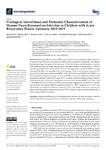2021-07-14Zeitschriftenartikel
Virological Surveillance and Molecular Characterization of Human Parainfluenzavirus Infection in Children with Acute Respiratory Illness: Germany, 2015–2019
Oh, Djin-Ye
Biere, Barbara
Grenz, Markus
Wolff, Thorsten
Schweiger, Brunhilde
Dürrwald, Ralf
Reiche, Janine
Human parainfluenza viruses (HPIVs) are important causes of respiratory illness, especially in young children. However, surveillance for HPIV is rarely performed continuously, and national-level epidemiologic and genetic data are scarce. Within the German sentinel system, to monitor acute respiratory infections (ARI), 4463 respiratory specimens collected from outpatients < 5 years of age between October 2015 and September 2019 were retrospectively screened for HPIV 1–4 using real-time PCR. HPIV was identified in 459 (10%) samples. HPIV-3 was the most common HPIV-type, with 234 detections, followed by HPIV-1 (113), HPIV-4 (61), and HPIV-2 (49). HPIV-3 was more frequently associated with age < 2 years, and HPIV-4 was more frequently associated with pneumonia compared to other HPIV types. HPIV circulation displayed distinct seasonal patterns, which appeared to vary by type. Phylogenetic characterization clustered HPIV-1 in Clades 2 and 3. Reclassification was performed for HPIV-2, provisionally assigning two distinct HPIV-2 groups and six clades, with German HPIV-2s clustering in Clade 2.4. HPIV-3 clustered in C1, C3, C5, and, interestingly, in A. HPIV-4 clustered in Clades 2.1 and 2.2. The results of this study may serve to inform future approaches to diagnose and prevent HPIV infections, which contribute substantially to ARI in young children in Germany.
Files in this item

